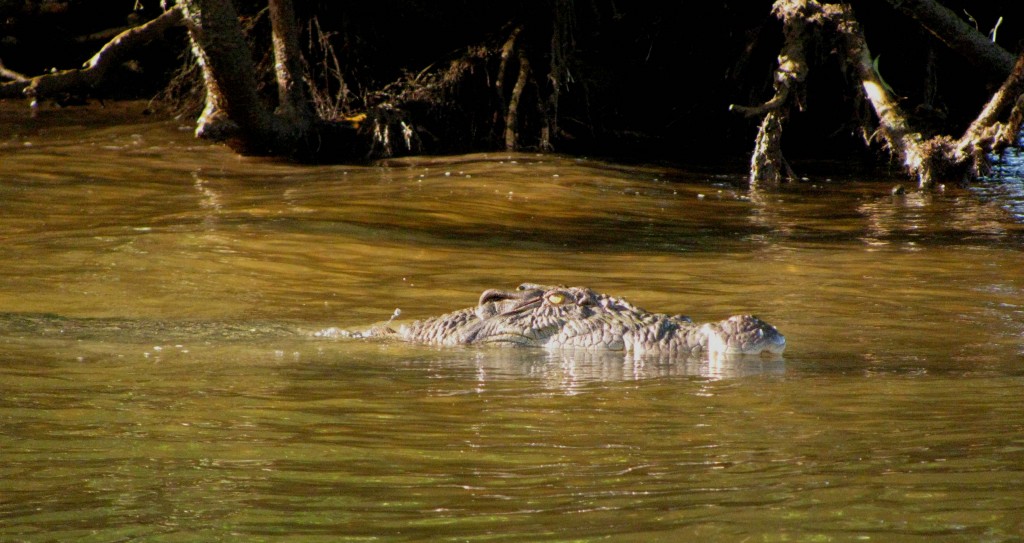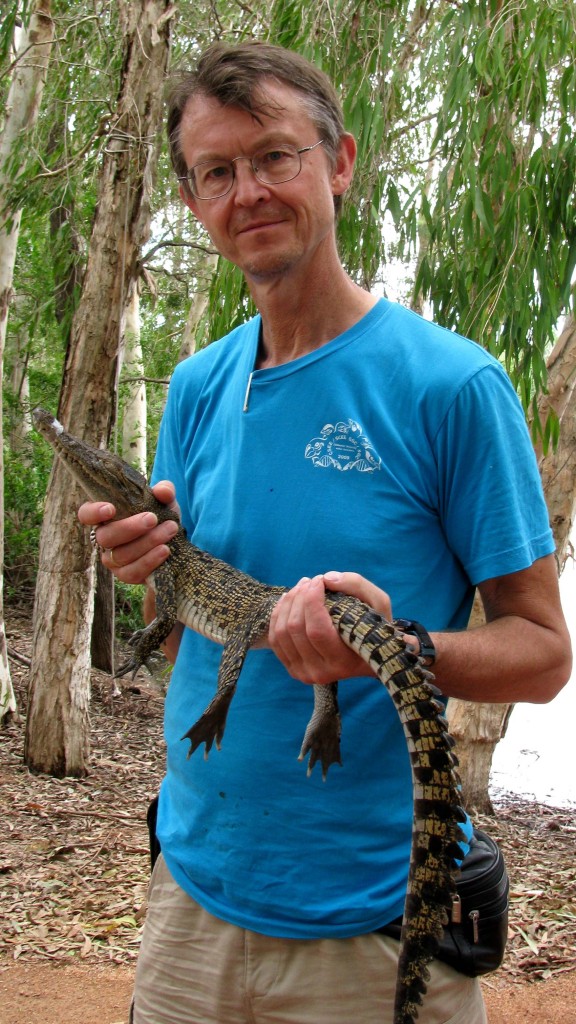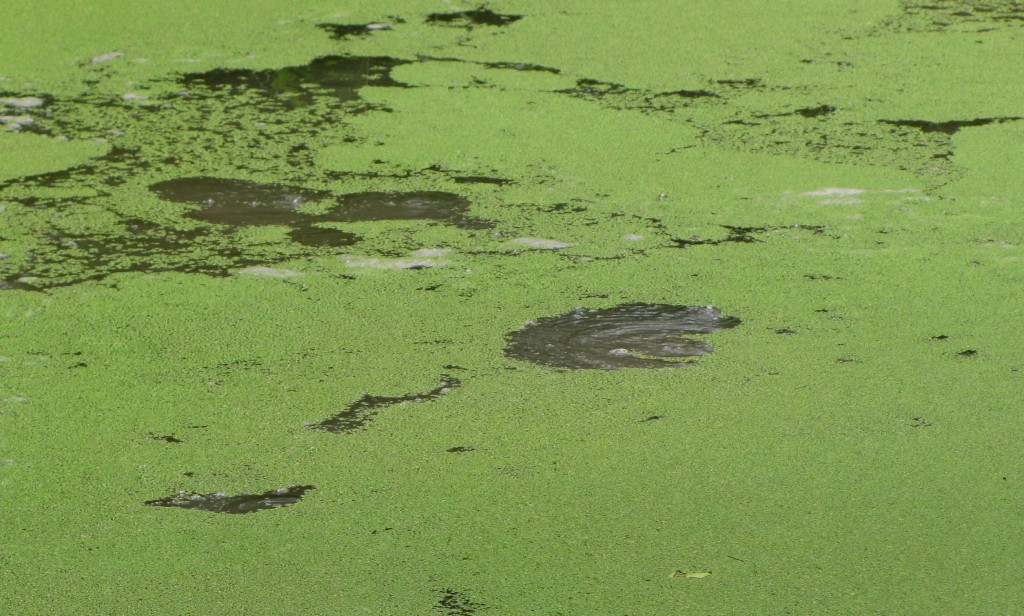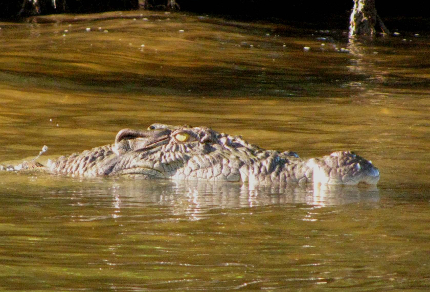Steady rain fell through the night, keeping me company through fitful sleep fraught with rambling thoughts, bouts of dozing, and residual pain following surgical removal of an ovarian cyst late yesterday morning. After breakfast, with my mind woozy from painkillers, I sat at my desk and, struggling to arrange my thoughts into coherent order, composed one post and then crashed into bed to sleep for hours. The staff at Townsville’s Mater Women and Children’s Hospital had been kind and generous with assistance, and the surgeon and anaesthetist pumped like elite athletes before a championship competition. I felt safe in their hands. I hope the post makes sense. This one’s about the big guys – saltwater crocodiles.

Saltwater Crocodile, Daintree River, Queensland (© Vilis Nams)
Before leaving Canada, I read up on potential severe dangers associated with living in Queensland. In addition to tropical cyclones, flash floods, extreme sunburn and dehydration, the list included a whole host of plants – stinging trees, for example – and animals. The list of animals ranged from potentially fatally venomous spiders and snakes through potentially fatally venomous cone snails and blue-ringed octopus through potentially fatally venomous box jellyfish and irukandji through potentially fatal bat-borne lyssavirus through potentially fatal attacks by saltwater crocodiles. I decided I would never put my hands or feet anywhere I couldn’t see exactly what was around them, I would never pick up a beach shell or reach into a tide pool, I would never swim in the ocean during the months of November through May (June this year because the marine stingers were still showing up in coastal waters), I would never touch a bat, and I would be ‘croc wise.’
The Queensland government provides nearly a full page of guidelines about safe human behaviour in crocodile country, which in Australia extends from southeast Queensland up around the top of the country to northern Western Australia.1 Both freshwater and saltwater crocodiles occur within this range, but the big salties are far more dangerous to humans than are freshwater crocodiles, which primarily hunt fish, crustaceans, frogs, birds, and smaller reptiles.1 The ‘be croc wise’ list included tips like paying attention to crocodile warning signs near waterways, staying out of any water in which a croc might be found even if no warning signs are present, standing back a few metres from the water’s edge while fishing, staying well away from crocodile slide marks, not cleaning fish or discarding fish scraps or food near the water’s edge, not washing up or preparing food or doing anything else at the water’s edge, not camping within 2 metres of high tide mark or 50 metres of the water’s edge, not approaching or harassing crocodiles, and not dangling enticing bits of flesh like arms or legs over the sides of boats.2

Vilis and Young Saltie, Billabong Sanctuary, Townsville (© Magi Nams)
Is all this really necessary? As Vilis and I learned through observation at Billabong Sanctuary in February, the answer is a definite ‘yes.’ At the sanctuary, we saw huge adult salties lazing on the muddy banks of pools or half in and half out of the water, their heavily-scaled bodies camouflaged with little green leaves of duckweed. Despite the fact that saltwater crocodiles reach lengths of 2 to 5 metres, and occasionally even 7 metres,1 some of those in the sanctuary were surprisingly difficult to distinguish from their surroundings. And when they slid into the duckweed-covered waters, it was impossible to detect their presence. As Vilis and I observed on the Daintree river, crocs can float with only their high-placed nostrils and eyes protruding from the water and move silently through water with barely a ripple. They are, as I read in Lynne Kelly’s book Crocodile: Evolution’s Greatest Survivor, ‘opportunistic gorge feeders,’3 meaning that they’ll go for any sizeable prey within reach, kill it and devour it, and then, after slowly digesting it with their sluggish reptilian metabolism, hunt again.
At the sanctuary, a crocodile handler rapped one big croc on the snout with a pole, causing it to open and snap its jaws shut with incredible speed and power, and with a sound that resembled a thunderous smack. Saltwater and Nile crocodiles have astonishing bite-forces, the highest of any living animal.4 At feeding time, the crocs slid into the water and disappeared from sight beneath the surface. When the handler extended meat on a pole to the edge of the water, a crocodile erupted from the pool and clapped the meat in its jaws before disappearing beneath the water again. All in an instant. The handler explained that the saltie is an ancient species that has survived, not because of intelligence, but because it does what it does extremely well. It typically hunts from the water, usually at the edge of land, and it’s fast and deadly. That’s why the Queensland government publishes ‘croc wise’ tips and erects crocodile warning signs beside tidal rivers and beaches.

Croc Pond at Billabong Sanctuary, with Ripple of Croc Movement in centre right (© Vilis Nams)
The most astonishing and awe-inspiring demonstration of the saltie’s hunting prowess came at the end of the sanctuary feeding show. The handler explained that crocs often swim along beneath tree branches overhanging water and will take birds out of the branches, even up to heights of several metres. He held a fish head attached to the end of a long pole up in the air at a height higher than his head, probably three metres or higher. The instant he extended that fish head out over the edge of the pool, a gigantic saltie exploded from beneath the water, exposing its entire body propelled upward by the spectacular power of its tail. The croc snatched the fish head in its jaws and splashed back down into the pool, instantly disappearing. If that fish head had been an egret, a black flying fox, or a child playing in the branches, it wouldn’t have stood a chance.
So, salties are a danger to humans, but they were here in Australia long before any humans were, so are a natural part of coastal ecosystems. Indigeous peoples hunted crocodiles for thousands of years without seriously depleting natural stocks, but white hunters committed full-scale slaughter of the big reptiles to obtain skins for the leather industry, resulting in severe population decreases by the 1960’s.5 Now, saltwater crocs are protected in the wild in Australia,6 but are also farmed for meat and leather.7 Their dangerously captivating character was broadcast round the world via Paul Hogan’s movie Crocodile Dundee and Steve Irwin’s television program The Crocodile Hunter. Still, it’s one thing to see this reptile’s speed and power on a screen, and quite another to watch it in real life.

Saltie Sinking out of Sight, Daintree River (© Vilis Nams)
References:
1. Steve Wilson and Gerry Swan. A Complete Guide to Reptiles of Australia. 2008. New Holland Publishers (Australia) Pty Ltd, Sydney, p. 22.
2. Queensland Government, Environmental Protection Agency. Crocodiles – Be croc wise. Updated 29 October 2008. Accessed Nov-2009. http://www.derm.qld.gov.au/wildlife-ecosystems/wildlife/living_with_wildlife/crocodiles/crocodiles__be_croc_wise.html
3. Lynne Kelly. Crocodile: Evolution’s Greates Survivor. 2006. Allen and Unwin, Crows Nest, New South Wales, p. 221; 4. Ibid, p. 68; 5. Ibid, pp. 145-152; 6. Ibid, p. 158; 7. Ibid, p. 193.


